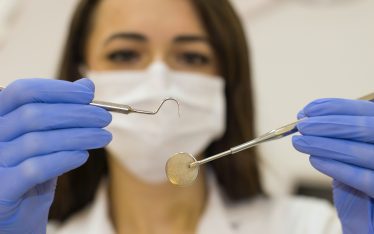I Am Missing A Tooth … What Do I Do?
When you find yourself with a missing tooth (or in a situation where you are going to lose a permanent tooth), there are a few options that you can consider.
The first thing to ask, however, is: “Does the tooth need to be replaced?”
While there are some instances where a missing tooth may not need to be replaced, such as for wisdom teeth or sometimes even second molars, in most cases replacing a missing tooth is recommended. There are several reasons why this is the case.
Leaving a tooth missing can have several consequences. If the space for the missing tooth is visible when you talk or smile, then not replacing it will have an unpleasing aesthetic result. Additionally, the teeth around the missing tooth space have are highly likely to shift. This can cause problems with your bite as well as resulting in a crooked or uneven smile. Once the teeth shift you may need to go through orthodontics (traditional bands and wires or possibly something like Invisalign) to correct the shifting.
This process can be costly and time-consuming.
The bone that held the tooth exists for one purpose only – to hold the root of a tooth. Once the tooth is gone your body will start to resorb the bone. This can cause a problem if, later on, you decide you want to have an implant placed to replace the missing tooth. If there is not sufficient bone left to place the implant then additional procedures (with additional cost and healing time) may need to be done to build the bone back up in order to place the implant.
Lastly, but definitely not the least in importance, having a missing tooth can cause difficulty chewing, especially if there are multiple missing teeth. For all of these reasons, replacing a missing tooth is usually recommended.
There Are Three Basic Ways of Replacing A Missing Tooth
1. Have a removable appliance fabricated.
This removable partial denture (RPD for short) usually will have either a full acrylic base or a metal substructure with acrylic in the areas of the missing teeth. Denture teeth are added to the appliance to replace the missing teeth. These RPD’s can be either temporary (usually done as full acrylic), or permanent (with a metal substructure for better long-term stability). Temporary RPD’s are used to provide a tooth while a site is healing from implant surgery, or to maintain surrounding tooth positions while the patient decides on which of the other options they would like to pursue. The advantages of an RPD is that one appliance can replace several missing teeth without additional expense (we don’t charge per tooth for an RPD), there is no surgery required, the cost is typically lower than the options that will be discussed next, and no major work has to be done on other teeth for an RPD to work.
There are several disadvantages as well.
First of all, because it is a removable appliance, there is often some movement of the device during chewing and it is possible for it to come loose at any time. Secondly, with the framework and acrylic it may well feel like you have a lot of “stuff” in your mouth, which can be annoying and hard to get used to. Lastly, RPD’s are prone to breaking and may need to be repaired occasionally.
2. Get a Bridge
If there is a tooth in good condition on either side of the missing tooth space, then a second option can be considered – a bridge.
When doing a bridge, the tooth on either side (after administration of anesthesia) is ground down like when doing a crown. A 3-tooth unit is then fabricated that fits over the ground down teeth and bridges the gap left by the missing tooth. In some cases longer span bridges can be done to replace multiple missing teeth. The bridge is cemented in place so that it cannot be taken out.
The advantages of this procedure are that it provides a very nice esthetics and it can be done very quickly. You will need one appointment to prepare the teeth and take an impression (either digitally or with impression material). A second appointment is needed to fit and cement the bridge Depending on the material being used, this could be a couple of days or a couple of weeks after the first appointment. You will have a temporary bridge in place for this time period. The disadvantages are that it is more expensive than the RPD and requires grinding down teeth on either side of the missing tooth. Once tooth structure is removed it cannot ever be replaced. Any time a tooth is worked on (whether for a filling, a dental crown or a bridge), there is a chance that the nerve inside of the tooth may become irritated. Most of the time when this happens it calms down on its own over time (usually days, but sometimes weeks or longer).
In some instances, however, the nerve becomes so irritated that a root canal will need to be done. This is fairly rare but does happen in a small percentage of cases. The last disadvantage is that a bridge ties multiple teeth together. This means that if any of the teeth supporting the bridge develop problems (such as cavities under the bridge – which can happen), the entire bridge will have to be removed and replaced. (See my blog post about how long a crown or bridge should last!) If a longer-span bridge is done, it is typically more likely to develop problems sooner than a short-span bridge.
3. Replace A Missing Tooth With An Implant
The last option is to do an implant to replace a missing tooth.
In most cases this is the most ideal approach. An implant is essentially a titanium screw that is placed in the bone that held the missing tooth. Once the bone heals and integrates with the implant – a process that usually takes 4-6 months – then a crown can be made and attached to the implant. As with the bridge, the crown is fixed in place so that you cannot take it off.
This option has many advantages.
First of all, it gives the underlying bone purpose again and helps to keep the bone from resorbing. Secondly, it allows us to leave the teeth surrounding the implant alone. If a tooth next to an implant develops problems later, it can be treated by itself. The esthetics for implant restorations are usually very good – provided the surgeon who placed the implant was able to put it in the correct position. Finally, restored implants are very stable and give the best function while chewing.
There are some disadvantages to an implant as well.
The first is that placement of the implant is a surgical procedure, though a pretty minor one. Because a 4-6 month healing time is needed before the crown can be made, this is a longer process than either the RPD or the bridge. Often an interim RPD is used during the healing time if the missing tooth is in the smile zone. In some cases, extra bone grafting is needed to improve the bone before an implant can be placed. This may mean an even longer healing period and possibly two surgeries (one to place the graft and a second surgery months later to place the implant). As far as cost is concerned, going the implant route is typically more expensive initially. However, due to the implants’ ability to allow us to leave the adjacent teeth alone, in the long run it will end up being less expensive than having bridges done multiple times over several decades. There is one final disadvantage to an implant, especially when it is being done to replace a molar. Implants are small round screws. Molar teeth are large and square/rectangle-shaped. Depending on how deep the implant is able to be placed, as we transition from the round implant to the tooth-shaped crown there is often a gap between the head of the implant and the adjacent tooth. This space can be visible when the implant is replacing a front tooth and can also allow food and debris to collect between the implant and the adjacent tooth. It is critical that if this occurs you keep the area cleaned out. You won’t get a cavity on an implant, but the presence of foreign material between the gums and the implant can cause irritation, inflammation, and bone loss around the implant. Unchecked, this can lead to implant failure. That is definitely something to avoid!
So, which choice is right for you?
It depends!
There are, of course, variations of each of these options and combinations of options that are too complicated to go into here.
If you have a missing tooth and would like to discuss how best to correct the situation, please give us a call at Mountain Springs Advanced Dental and we will help you make the choice that is right for you.





